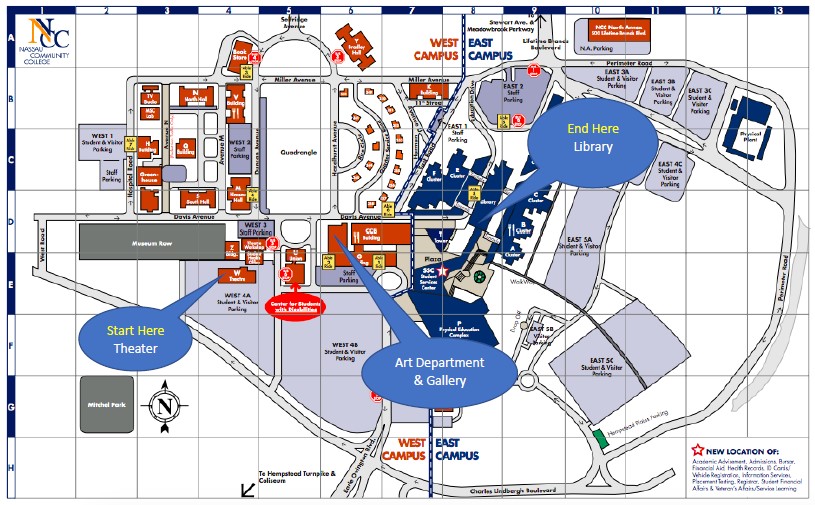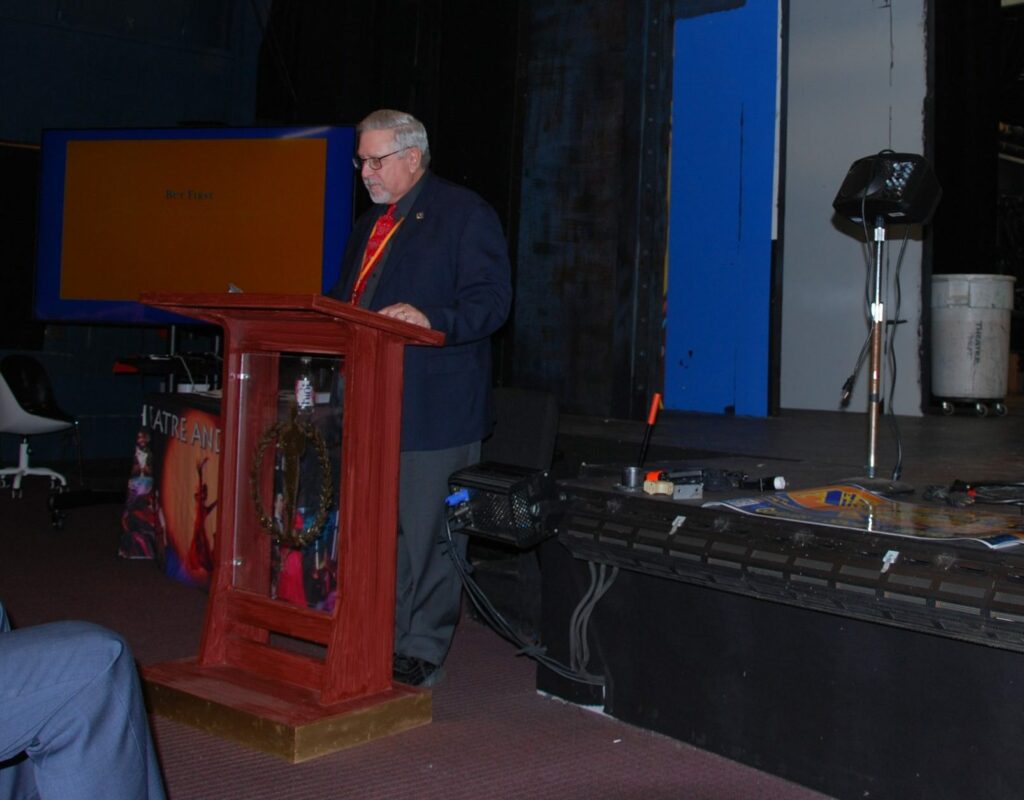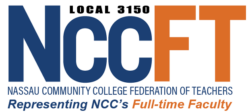On Thursday, April 14, we were delighted to provide a tour to members of the Nassau County Legislature: Presiding Officer Richard Nicolello, Alternate Deputy Presiding Officer Denise Ford, Legislator John J. Giuffrė, and Legislator Steven Rhoads. Given time constraints, our tour focused on the Theatre Department, Art Department, and a quick pass-through of the Art Gallery and Library. Chairpersons Richard GInsburg and Izolda Maksym gave informative presentations, displaying the talent of our students, alumni, and faculty, noting what is needed to preserve their programs, and showing their programs’ cultural and economic contributions to the County. NCCFT Vice President Dr. David Stern led the tour with President Dr. Faren Siminoff, Secretary Dr. Suzanne Kaebnick, and Chairperson Thomas Bruckner assisting. Professor Frances Viscovich and several Achilles/ Aspires students stopped by to personally thank Nicolello and the Nassau County legislature for saving the Achilles/ Aspires programs when they threatened to withhold the college budget if the programs were not restored. Cabinet members Vice President Julio Izquierdo, Vice President Adrian Kerrigan, and Associate Vice President of Facilities Management Phillip Cappello were also in attendance.
Ginsburg asked our elected leaders to “polish the gem” that is NCC. He noted that “we have 1,000’s of working alumni in the multi-billion-dollar” industry of Theatre Arts, and “we have had 10 former students on SNL, not including Billy Crystal, Bob Nelson, and Jim Brurer.” Other well-known graduates include Lea Tyrrell and Antoinette Biordi of Channel 12. (Ginsburg presented this short clip in which several graduates describe their experience at NCC. College marketing should work with Ginsburg and other professors to do likewise; it was inspiring!) Ginsberg pointed out that there are “national companies clamoring for creative artists who can write copy, produce videos, scripts, commercials, act, shoot, and create content for direct sales and advertising. Theater technology is a growing field in film, television, and internet sales.”
For the Theatre Department to continue to serve Nassau County as it has, it needs increased funding for tenured, full-time faculty. This is necessary to keep program accreditation and run its three programs in acting, dance, and technical theater. Currently, the Theatre Department has only 2 full-time faculty, down from 10. He noted that SUNY’s guidelines for the 3 discrete programs state there should be “at least 1 full-time teaching faculty member per degree.” Full-time faculty also support student success: they “recruit, rebuild, and retain students and their dreams. And their families’ dreams.” The fact that the program grew during Covid, 19% over last spring, is telling. In a time when people feel alone, traumatized, and depressed, theater is a lifeline. The theater department also needs its technologists: because what is stagecraft without lighting, audio, and film technology. How do you run a program in technical theater without the help of its technologist?
Ginsburg also urged our legislators to invest in a Performing Arts Center, which would support the arts in NCC, in Nassau County, and create jobs and new businesses. The current building for the theater was meant to be a temporary dwelling. A Performing Arts Center would support student training and work in fields like “entertainment technology, performance, music, fine art, communications and television, American Sign Language, the culinary arts, food service administration, and restaurant management”. It would create numerous possibilities for productive internships and create possibilities for students to work with professionals. It would be a gathering place for Nassau County. The State has twice offered 20 million if the County would match it for building a Performing Arts Center. We shouldn’t turn such an enriching future down.
Chair Izolda Maksym, who, incidentally, is also a shining example of one of NCC’s successful alumni, similarly stressed that the Art Department needs to hire full-time faculty in order to support and run current programs and begin much anticipated new ones like interdisciplinary fields in computer gaming. Jason Gorman, who teaches computer graphics, graphic design, web design, 3D and video in the Art Department, elaborated that the department would like to develop 4 new degree programs for Web Development and Design, UX/UI Design, Game Design, and Animation, but the paperwork to develop the programs, let alone to teach and evaluate them, necessitates hiring more full-time faculty. Funding for technologists is also sorely felt in the Art Department, which like all the departments, had its technologists, Michael Gallo and Larry Chatterton, who take care of 7 or more labs and around 100 computers, relocated to IT last December. Technologists are core faculty; they may not be classroom faculty, but they do teach in the labs and studios that they monitor and maintain, such as the labs for analogue and digital photography in Art.
Regular, systematic maintenance has been an issue in the G building, which houses the Art Department. A tour of the ceramic and sculpture room and the basement computer labs highlighted where mold and flooding have occurred as well as the ventilation problems. The ceramic and sculpture room has a wonderful skylight, but the vents, although no longer moldy, were stressed-looking. President Siminoff whose history classes are also housed in the G building noted that its bathrooms have been badly in need of repairs. The Plaza Art Gallery in the Tower presents a clever conversion of office space, but ongoing water leaks have damaged it.
We finished the tour with a quick peek at the Library, where Associate Vice President Phillip Cappello summarized the roof repairs that are almost completed, and we bemoaned the 40-year-old stained and threadbare orange carpeting and marveled at its long bare patches. Stern noted the College’s possible plan to break up the library space to add classrooms; the problem with it is that students use this library space for group study, a practice that has been shown to boost student learning. Students who study together, do better. We cannot afford to lose the limited space we have for group study.









One Response
For those who are interested in the history of NCC, note that the facility currently used by our illustrious Theatre Department originally house the Printing & Publications unit of the College! A project to replace the carpeting in the Library was originally scheduled to to begin in 1987! The first “phase” of replacement began in 2001. The rest of the project was never begun!
In the late 1980s, a candidate for the position of VP/Academic Affairs toured our facilities on his own. At his interview he noted that our College must be on a “deferred maintenance” program! This condition has not changed in more than 30 years!